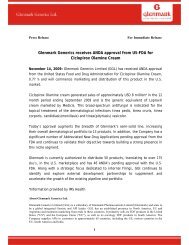Download - Glenmark
Download - Glenmark
Download - Glenmark
You also want an ePaper? Increase the reach of your titles
YUMPU automatically turns print PDFs into web optimized ePapers that Google loves.
3.2 PRESENTATION OF FINANCIAL STATEMENTS<br />
The consolidated financial statements are presented in accordance with IAS 1 Presentation of Financial<br />
Statements (Revised 2007), except as indicated in Note A-2.2 above. The Group has elected to present<br />
the ‘Statement of comprehensive income’ in two statements: the ‘Consolidated Income statement’ and the<br />
‘Consolidated Statement of Other Comprehensive Income’.<br />
In future periods, two comparative periods will be presented for the statement of financial position when the Group:<br />
(i) applies an accounting policy retrospectively,<br />
(ii) makes a retrospective restatement of items in its financial statements, or<br />
(iii) reclassifies items in the financial statements.<br />
3.3 BASIS OF CONSOLIDATION<br />
The Group’s financial statements consolidate those of the Company and all of its subsidiary undertakings drawn<br />
up to the dates specified in Note B. Subsidiaries are all entities over which <strong>Glenmark</strong> Pharmaceuticals Limited<br />
has the power to control the financial and operating policies. In assessing control, potential voting rights that<br />
currently are exercisable are taken into account. The financial statements of subsidiaries are included in the<br />
consolidated financial statements from the date that control commences until the date that control ceases.<br />
<strong>Glenmark</strong> Pharmaceuticals Limited ob tains and exercises control through voting rights.<br />
Unrealised gains and losses on transactions between the Company and its subsidiaries are eliminated. Where<br />
unrealised losses on intra-group asset sales are reversed on consolidation, the underlying asset is also tested<br />
for impairment losses from the group perspective. Amounts reported in the financial statements of subsidiaries<br />
have been adjusted where necessary to ensure consistency with the accounting policies adopted by the Group.<br />
Profit or loss and other comprehensive income of subsidiaries acquired or disposed off during the year are<br />
recognised from the effective date of acquisition, or up to the effective date of disposal as appropriate.<br />
Non-controlling interests are presented in the consolidated statement of financial position within equity,<br />
separately from the equity of the owners of the parent.<br />
Non-controlling interests represent the portion of a subsidiary’s profit or loss and net assets that is not held by<br />
the Group. Profit or loss and each component of other comprehensive income are attributed to the owners of the<br />
parent and to the non-controlling interests. Total comprehensive income is attributed to the owners of the parent<br />
and to the non-controlling interests even if this results in the non-controlling interests having a deficit balance.<br />
3.4 BUSINESS COMBINATIONS<br />
Business combinations are accounted for using the purchase method. The purchase method involves the<br />
recognition of the acquiree’s identifiable assets and liabilities, including contingent liabilities, regardless of<br />
whether they were recorded in the financial statements prior to acquisition. On initial recognition, the assets<br />
and liabilities of the acquired subsidiary are included in the consolidated statement of financial position at their<br />
fair values, which are also used as the basis for subsequent measurement in accordance with the Group’s<br />
accounting policies.<br />
Goodwill is stated after separating out identifiable intangible assets. Goodwill represents the excess of<br />
consideration transferred and any non-controlling interests over the fair value of the identifiable net assets of<br />
the acquiree at the date of acquisition. Any excess of identifiable net assets over the consideration transferred<br />
and any non-controlling interest is recognised in income statement immediately after acquisition as a ‘gain on<br />
bargain purchase’.<br />
3.5 FOREIGN CURRENCY TRANSLATION<br />
The consolidated financial statements are presented in Indian Rupees (‘INR’), which is also the functional<br />
currency of the parent company, <strong>Glenmark</strong> Pharmaceuticals Limited, being the currency of the primary economic<br />
environment in which it operates.<br />
Foreign currency transactions<br />
Transactions in foreign currencies are translated to the respective functional currencies of entities within the<br />
Group at exchange rates prevailing at the dates of the transactions. Foreign exchange gains and losses resulting<br />
from the settlement of such transactions and from the remeasurement of monetary items at year-end exchange<br />
rates are recognised in income statement. Non-monetary items measured at historical cost are translated using<br />
the exchange rates at the date of the transaction (not retranslated). Non-monetary items measured at fair value<br />
are translated using the exchange rates at the date when fair value was determined.<br />
Foreign currency gains and losses are reported on a net basis.<br />
Foreign operations<br />
In the Group’s consolidated financial statements, the assets, liabilities and transactions of foreign operations<br />
are translated into INR, the Group’s presentation currency upon consolidation. The functional currencies of the<br />
entities in the Group have remained unchanged during the reporting period.<br />
On consolidation, liabilities have been translated into INR at exchange rates at the reporting date. Goodwill and<br />
fair value adjustments arising on the acquisition of a foreign entity have been treated as assets and liabilities of<br />
84<br />
GLENMARK PHARMACEUTICALS LIMITED



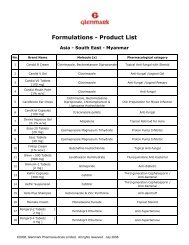


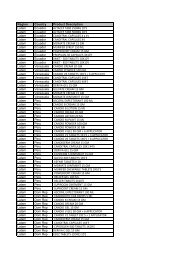
![Formulations [India] â Product List - Glenmark](https://img.yumpu.com/46601329/1/190x245/formulations-india-a-product-list-glenmark.jpg?quality=85)
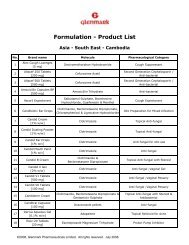
![Formulation [India] â Product List - Glenmark](https://img.yumpu.com/44013338/1/190x245/formulation-india-a-product-list-glenmark.jpg?quality=85)


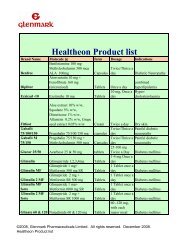
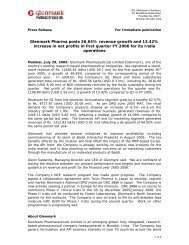
![Formulations [India] â Product List - Glenmark](https://img.yumpu.com/35994839/1/190x245/formulations-india-a-product-list-glenmark.jpg?quality=85)
